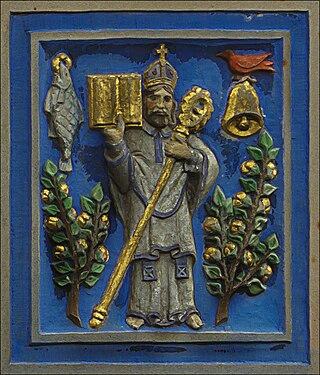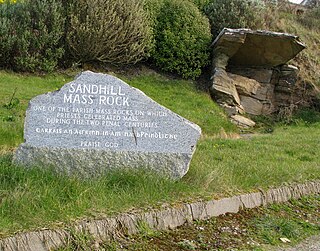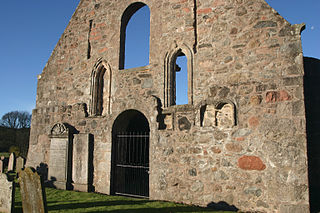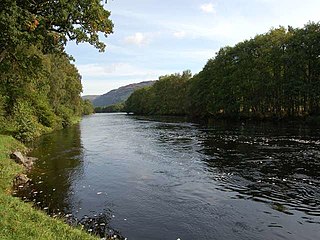Ternan's disciple, Erchard, it is almost certain, penetrated far into the northern territory. A tradition which has probably come down from his own time tells that he was the first who preached the gospel in Glenmoriston, and to him the ancient church of that Glen—Clachan Mhercheird was dedicated.
Erchard, or Merchard, as he latterly came to be called, was a native of the district of Kincardine O’Neil, on the southern slopes of the Grampians. He became a zealous Christian in his early youth, and Ternan not only ordained him priest, but also appointed him his own coadjutor. It was perhaps while he laboured with Ternan that he visited our Parish. In after life he went to Rome, and was consecrated bishop by Pope Gregory. On his return journey he visited the Picts of Pictavia, now Poitou, in France, and brought back to the truth such of them as had lapsed into paganism. Falling sick, he prayed God that he might not see death till he arrived in his own country, and hastened northward through France and England. He reached Kincardin O’Neil to be honourably received by his people, and then died. According to his own instructions, his body was placed on a cart drawn by two horses, which were allowed to go forth where they listed. He was buried where they first stopped, and a church was built over his grave.
Such, briefly, are the circumstances of his life and death, as given in the Breviary of Aberdeen and other ancient writings. Much more is told of him in the traditions of Glenmoriston. While labouring in Strathglass with two missionary companions, his attention was drawn to a white cow which day after day stood gazing at a certain tree, without bending its neck to eat, and yet went home each evening as well filled as the other cattle. Curiosity, or a higher influence, led him to dig up the earth at the foot of the tree, and there he found three bells, new and burnished as if fresh from the maker’s hands. Taking one himself, and giving the others to his companions, he bade each go his own way and erect a church where his bell should ring the third time of its own accord. One went eastward, and founded the church of Glenconvinth; another westward, and erected his church at Broadford in Skye; while Merchard himself travelled southward in the direction of Glenmoriston. When he reached the hill now called Suidh Mhercheird, or Merchard’s Seat, his bell rang for the first time; it again rang at Fuaran Mhercheird (Merchard’s Well) at Ballintombuie; and it rang the third time at that spot by the side of the Eiver Moriston which is now the old burying-ground of Glenmoriston. There he built his church—Clachan Mhercheird; and there and in the surrounding districts he for a time taught and preached. He became the patron saint of Glenmoriston; and his solicitude for the Glenmoriston people has not yet ceased. His acts of mercy and love have been without number. One example may be given. In former times, when a tenant died, his best horse went to the proprietor as each-ursainn—herezeld, or heriot. If the deceased left no horse, a horse's value was taken in cattle or sheep. On one occasion—twelve hundred years after Merchard’s death—it came to pass that a poor Glenmoriston tenant died, leaving a widow to succeed him. He had left no horse, and the ground-officer took the heriot in sheep. That same night, as the officer lay in bed, an unearthly voice spake to him:—
’S mise Merchard mor nam feart,
’S mi dol dachaidh chum an anmoich;
Is innis thusa do Mhac-Phadruig
Nach fheaird e gu brath a’ mheanbh-chrodh!
(“I am great Merchard of the miracles, passing homeward in the night. Declare thou unto Mac Phatrick [the laird] that the widow’s sheep will never bring him good.”)
With the morning’s sun the terror-stricken man appeared before his master and delivered the ghostly message. The sheep were instantly returned to the widow, and from that day until now no heriot has been exacted in Glenmoriston. Merchard’s bell was preserved at his clachan until about the year 1870, when it went amissing—removed, it is supposed, by strangers employed in the district. Its powers and attributes were of a wonderful order. It indicated, as we have seen, where Merchard’s church was to be built. Until the very last the sick and infirm who touched it in faith were strengthened and cured. After the church became ruinous, in the seventeenth century, the bell was kept on an ancient tombstone, specially set apart for it. If removed to any other place it mysteriously found its way back. When a funeral approached, it rang of its own accord, saying, “Dhachaidh! dhachaidh! gu do leabaidh bhuan!”—“Home! home! to thy lasting place of rest!” If thrown into water it floated on the surface, but this the people were slow to put to the test, in deference to Merchard’s warning:—
’S mise Merchard thar an fhonn:
Cuimhnichibh trom trom mo shàr’adh;
’S fiach’ nach cuir sibh air-son geall
An clag so air a’ pholl a shnamhadh.
(“I am Merchard from across the land: keep ye my sufferings deep in your remembrance ; and see that ye do not for a wager [or trial] place this bell in the pool to swim.”)
 This article incorporates text from this source, which is in the public domain.
This article incorporates text from this source, which is in the public domain. This article incorporates text from this source, which is in the public domain.
This article incorporates text from this source, which is in the public domain. This article incorporates text from this source, which is in the public domain.
This article incorporates text from this source, which is in the public domain.











